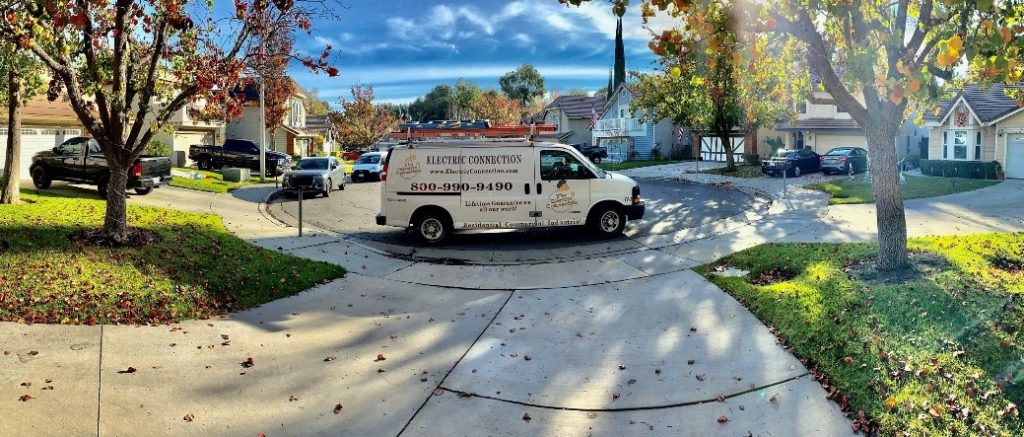By Alexandra Hopkins Jan. 18, 2022
The employees of our electrical contracting company share in our profits and do quite well for themselves. But we didn’t set out to compensate our employees better than most of our competition. We did so as an act of desperation, a last-ditch effort to avoid bankruptcy.

Well, Kim’s van wasn’t this bad…
In 1979, my husband Kim, age 25, started The Electric Connection. He drove his beat-up van around Los Angeles doing small electrical jobs with the help of a part-time electrician’s helper. They installed light fixtures and electrical outlets; they wired bathroom additions; and they explored the mysteries of doorbells which refused to ring. Kim tended a home office between electrical jobs—a desk, a telephone, and an answering machine. The company earned a small profit.
We Balloon Out
In 1983, I came aboard to run the office. Having someone in the office set the stage for expansion. Between the two of us, within a couple of years, Kim and I grew our company to 40 employees. Wow, you might think, that’s great! But…not so much.
We were subcontracting to large building contractors. Teams of our electricians wired large high-end restaurants and celebrity mansions in the Hollywood Hills. Kim and I were working crazy-hard, and we thought we were on the road to riches. We didn’t notice flashing red lights warning of a cliff— contractors we worked for weren’t paying us on some big jobs, and we had unending personnel problems with our electricians.
It turns out that electricians are not like guys who wear a tie to the office 9 to 5. They are cowboys. John, for example, one of our more skilled electricians, would sometimes fail to show on a construction job for a few days. Why? He was off on a bender. Other electricians would show up late or not show up at all. Wire and tools from our trucks went missing. With so many electricians working at different job sites each day, it was hard to keep an eye on them.
In one memorable incident, our bank called Kim complaining about our electricians. Unbeknownst to us, every Friday morning, rather than go directly to their jobs, they would immediately drive to our bank and cash their pay checks. And then they would hang around the lobby, chatting and smoking. We learned that we were paying our electricians hundreds of dollars to annoy bank tellers.
We Pop

The Sheriff came knocking at our door.
Not surprisingly, we were losing money—fast. Soon, we weren’t able to keep up with company bills. The low point came around 1987. Early one morning when it was still dark out, the doorbell rang. Sleepily, we opened the door to see a Sheriff’s Deputy waiting to serve us with papers. We were being sued for non-payment of an electrical wholesale house bill. Between wholesale house bills and back payroll taxes, we were in debt by $300,000. In 2021 dollars, this was over $700,000!
Someone else might have declared bankruptcy. And we certainly considered it—I considered it more seriously than Kim. But he is made of sterner stuff. Kim was determined that we would work our way out of the hole we had dug. The first step–stop digging.
We Stop Digging
We stopped working for building contractors, many of whom favored stiffing their subcontractors. We returned to working directly for homeowners, doing service calls and small remodels.
But we had another troubling problem that it took us longer to appreciate: our electricians were making a lot of money while our company was losing A LOT. Haunted by the memory of paying electricians by the hour to chat and smoke, we knew we had to align employee incentives with company profitability. Kim started implementing the basics of our pay system, which I’ll call “Partner Pay.” We partnered with each electrical team on each job. An electrical team is a journeyman electrician and a helper. In the legal sense, we weren’t partners, but we partnered with our electrical teams in getting the job done and splitting the profit.
Partner Pay
Here’s a highly simplified description of how Partner Pay works: We start with minimum wage—every hour that our electricians work, they earn minimum wage. This allows us to meet California State Labor Law. On top of the hourly wage, our journeyman electricians earn a large bonus. This is a percentage of the profit on each job that they complete. The profit is the amount the customer pays for the job, less its expenses. Expenses include electrical materials, the labor costs of the electrician’s helper, office expenses, and so on.
Taking the price that the customer pays and subtracting expenses, we arrive at profit. We divide the profit on each job three ways, 1/3 to the journeyman electrician with a portion to the helper; 1/3 to the company for reinvestment and growth; and 1/3 to management. Management includes Kim and me, our Field Supervisor, and office staff.
What about office staff? If the company makes no profit, office staff receive only salary. Under California law, salary is at least twice minimum wage, although most of our office staff earn significantly more than that. But if the company makes a profit during the quarter, they are awarded with their share of management’s portion of profit, split equally among them.
Complications
Partner Pay is a simple idea. But refining it so that it creates the benefits that we hoped for has literally taken decades. Kim learned by trial and error the percentage splits that work best. He also learned how to refine the pay system to conform to the requirements of California employment laws.
Other Aspects of Partnering with Our Employees
Partner Pay is only one of the ways in which we partner with our employees. Many other aspects of our work together are important:
• Shared sense of mission,
• Investments in staff training and in equipment that increases their efficiency,
• Supportive work environment,
• Good benefits like health insurance and 401k, and
• Providing challenges that engage employees in developing their talents and skills towards their career goals.
Results of Partnering with Employees
When we first began Partner Pay in 1987, we were well on our way to bankruptcy. We had already shrunk down to 15 electricians…and Partner Pay accelerated the trend. Within one short week of implementing Partner Pay, half our electricians quit. Why? These electricians worked slowly or made costly mistakes. So, their jobs weren’t profitable. They were earning minimum wage, but there was little or no profit to split. They were taking a big cut in pay.
But those who could work efficiently with few errors could make a good profit. In fact, the electricians who stayed with us immediately started earning about 50% more than they had with our old hourly pay system.
Partner Pay left us with seven excellent electricians. We slowly rebuilt the company. Over the years, our profit has risen and fallen with the economy. But we’ve always managed to stay in business while avoiding layoffs. Since 2012, we’ve been back up to a stable 30-person company. It has been running highly profitably for both management and employees.

One of our new, improved vans.
Kim and I have been taking home six-figure incomes and so have several of our employees, including both electricians and office staff. Our office staff work so well together that I’ve been able to retire from office management, and Kim is now semi-retired.

Our office in Tujunga, California, 2020, just before we sold it. We went with the Pandemic flow, and our office staff now all work from home.
Kim and I also have the satisfaction of doing quality electrical work for our customers while providing good, stable financial support for about 30 families. Our high employee retention rate attests to the job satisfaction of our employees.
A Model for Capitalism?
At this time, American capitalism is under attack. Many Americans are dismayed by widening income inequalities as well as the disastrous impact that unrestrained profit-seeking has on the ecology. I’m afraid that partner pay has little to offer when it comes to the ecology; but it could be a step towards reducing income inequalities. Through Partner Pay, companies could bring employees into the economy on a more equal footing while still earning good profits for themselves.
Partner Pay could be a model for other small businesses and perhaps even for large corporations. What if Amazon or Walmart, for example, split their profits three ways? One-third to the employees; 1/3 to the company for reinvestment and growth; and 1/3 to the stockholders.
Income inequalities in the U.S. could trend down. And working people would have more money in their pockets to buy the products that they produce. Today’s corporations could walk in the footsteps of Henry Ford, who led the way in paying decent wages to assembly line workers.
He had the foresight to see that decent wages would allow factory workers to buy the Model T’s that they assembled.
Clearly, Partner Pay isn’t a panacea for all our economic and ecological ills. But it’s a step forward that is within the control of individual employers and employees. We don’t have to wait for attitudes in the broader society to change or for the passage of new laws. It’s a step that puts into action a new mindset. It’s a mindset of not just putting in your hours, but efficiently producing good quality work for customers. It’s a mindset of cooperating, sharing, and considering the welfare of colleagues. With this mindset, we can overcome some of the problems that American capitalism faces today.

Kim Hopkins, around 2016.
For more information on how we run our business, listen to the podcast “Insights from 40 years running an Electrical Service Co–The Electric Connection’s Kim Hopkins.”